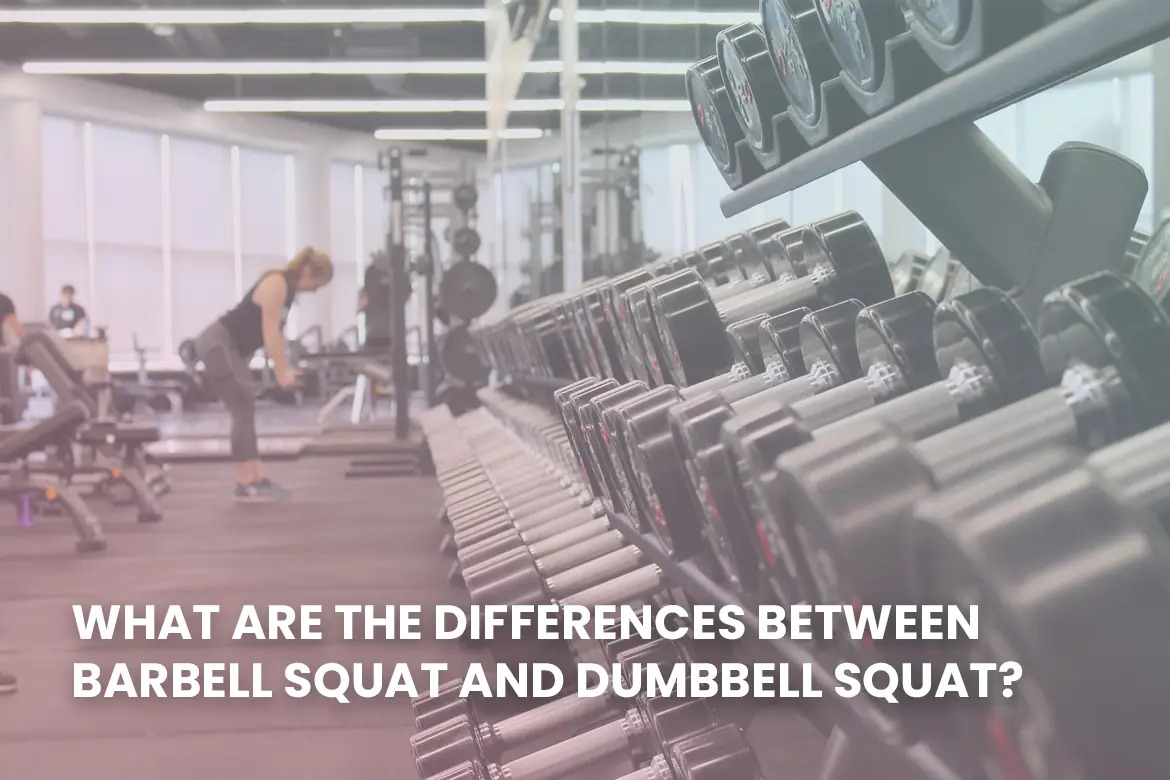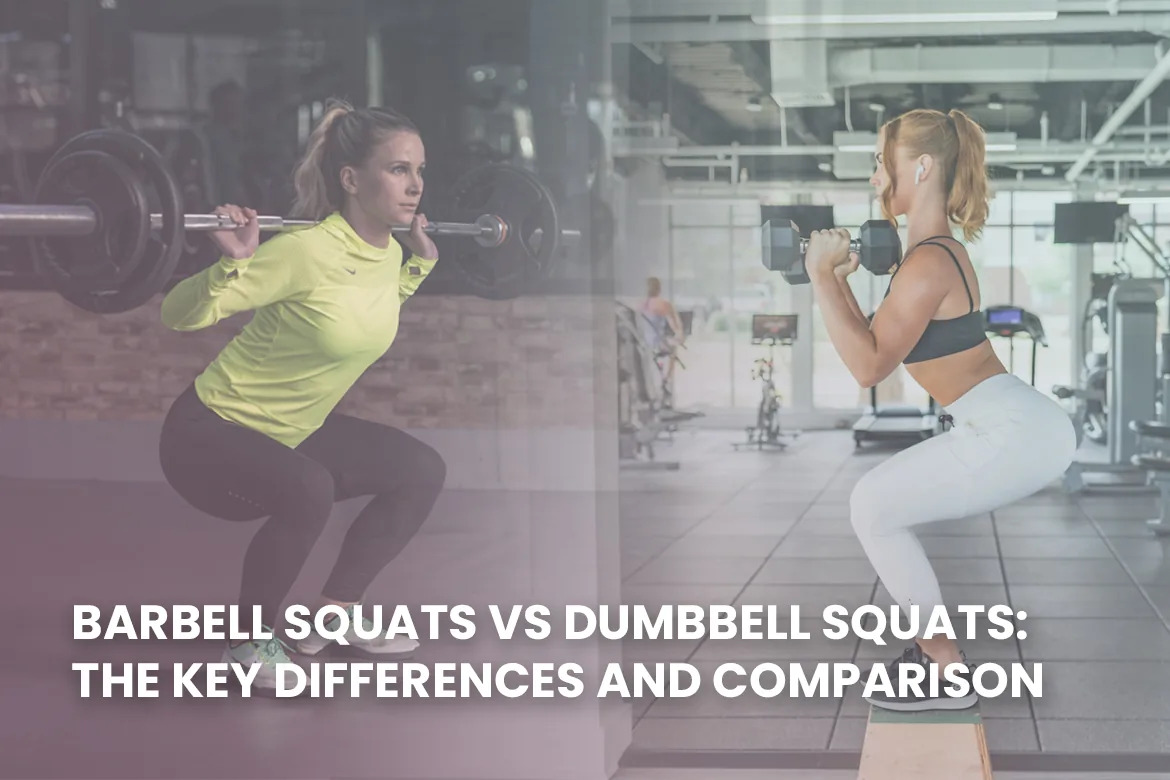When it comes to building muscle in the body, it is incredibly important to know what each of the exercises in your workout are for in order to achieve the best results. This can become confusing for some people, especially since some exercises are almost identical to one another, with only a few differences between them. Such is the case for barbell squats and dumbbell squats. From the name itself, it's evident that these two exercises are almost identical. They're both squats. The difference is that one is done with a barbell, while the other requires dumbbells. But what could be the difference between the two? Why can't we just do one of them? Does the barbell squat target certain muscles that the dumbbell squats can't? In this article, we will compare barbell squats vs dumbbell squats and answer the most burning questions about the two exercises.
What is a Barbell Squat?
A barbell squat is a weight-training exercise that works the shoulder calisthenics exercises muscles in the lower body. This compound movement is considered one of the most effective exercises for building strength and muscle mass. It involves controlling the barbell as you move through a full range of motion, typically from standing to sitting position and back up again with your feet shoulder-width apart.
The main benefit of doing barbell squats is increased muscular strength and power, which can improve athletic performance or help reduce injury risk. The exercise also builds muscle endurance in the legs, glutes and core muscles, as well as improving coordination and balance. Additionally, it stimulates hormones such as testosterone which can boost overall energy levels throughout the day.
Related: Mastering the DB Drop Squat: Benefits and Proper Form
What is a Dumbbell Squat?
A dumbbell squat is a popular lower body exercise used to build leg strength and tone muscle. It's important to understand the differences between the barbell squats and the dumbbell squats, so you can choose the best workout for your goals. With this article, we'll compare both of these exercises to help you decide which one is best for you.
The main difference between a barbell squat and a dumbbell squat is that in a barbell squat, weight is distributed over both shoulders while in a dumbbell squat, weight is concentrated on each side of the body. This means that with a barbell squat, you can lift heavier weights than with a dumbbell but with increased instability since it requires more balance. On the other hand, using two dumbells adds more stability but limits how much weight you can use since each arm has its own resistance.
What are the Benefits of Barbell Squats?
Strengthens the Core Muscles
Whether you're a fitness enthusiast looking to bulk up or someone who wants to improve their strength and overall health, the core muscles are essential. Strengthening them is key in achieving the desired results from your workouts. One way of doing that is by performing squats, which can be done with either a barbell or dumbbells. In this article, we explore the differences between these two exercises and compare their effectiveness in strengthening the core muscles.
The main difference between barbell squats and dumbbell squats is that while barbell squats require you to use both hands - one on each side of the bar - when performing the exercise, dumbbells are held in one hand each, allowing for more freedom of movement while exercising. This makes them better suited for those looking to increase flexibility and range of motion.
Related: Master the One Leg Dumbbell Squat for Leg Day Success
Barbell Squats Target the Lower Muscles
Barbell squats are a popular exercise that target the lower muscles of the body. This type of squat is often used as a building block for other exercises, such as deadlifts and lunges. Compared to dumbbell squats, barbell squats provide greater overall stability and strength development due to the use of heavier weights. As a result, many people use barbell squats as part of their workout routine in order to build up their leg and core muscles.
When performing barbell squats correctly, users will feel the tension in their glutes, quads, hamstrings and calves after each repetition. While this exercise can be difficult for beginners at first, it’s very effective when done correctly since it forces you to use multiple muscle groups simultaneously.
Crushes Calories
When it comes to getting in shape and burning off excess calories, a number of exercises can be used to reach your goals. But if you are looking for a particularly effective exercise that crushes calories, then consider barbell or dumbbell squats. Squats are an excellent way to build strength and muscle size while also helping you lose weight.
The key difference between the two exercises is the equipment used - with barbell squats requiring a large barbell and dumbbell squats using smaller weights, usually held in either hand. While both versions of the squat work similar muscles groups – including your quads, hamstrings, glutes and core – they each have unique benefits due to their different equipment set-up.
Barbell squats tend to be more effective at increasing muscle mass than dumbbell squats as they allow for heavier weight lifting within a single rep range.
Related: Mastering DB Front Squats: Tips and Techniques
Boosts Athletic Ability
Athletes of all levels are always looking for ways to boost their athletic ability. One way to do so is by understanding and comparing the differences between barbell squats and dumbbell squats.
Barbell squats allow athletes to lift heavier weights with greater stability, making them a great option for developing strength in the lower body muscles needed for explosive power and speed. On the other hand, using dumbbells helps reduce potential imbalances in muscle development and can be a better choice for those who lack coordination or experience pain when performing barbell squats.
By recognizing both exercises’ benefits and drawbacks, athletes can maximize their gains while minimizing risk. Read on to learn more about how barbell vs dumbbell squats compare, as well as how they each contribute to enhancing an athlete’s overall performance!
Related: Dumbbell Back Squat: Build Lower Body Strength Efficiently
What are the Benefits of Dumbbell Squats?

The Dumbbell Squat is Versatile and Can be Modified
The barbell squat is a popular exercise that works multiple muscles of the lower body at once. However, the dumbbell squat can offer similar benefits and more versatility. The dumbbell squat is an effective and convenient tool for strength training, regardless of goals or fitness level.
The dumbbell squat can be modified into other exercises such as the front squat, Bulgarian split squat, overhead squat, and more! The Dumbbell Squat is a Functional Exercise The dumbbell squat can be beneficial for many different workouts, including aerobic activities, sports training, and weight training. In addition to being an effective exercise for building muscle, the dumbbell squat helps strengthen your body's core and lower back.
Strengthens the Core Muscles
When it comes to building strength, there are few exercises more effective than squats. Squats of all types can help to strengthen the core muscles and build an overall stronger physique. Two popular variations of squats are barbell squats and dumbbell squats, and both offer a great opportunity for strengthening the core.
This article will discuss the key differences between barbell and dumbbell squats, as well as provide a comprehensive comparison so that you can decide which type is best suited to your goals. Whether you’re looking to target specific muscle groups or increase strength in your lower body, one of these two types of squats could be just what you need.
Beneficial for Younger People due to Lighter Weights
Barbell squats and dumbbell squats are two popular exercises that have been around for decades. They provide a great way to build strength, tone muscles, and improve overall health. But which one is better for younger people?
While both types of squats offer beneficial fitness results, many experts agree that barbell squats are generally more suitable for older athletes because they involve heavier weights. On the other hand, dumbbell squats can be a great choice for younger people as they involve lighter weights that allow them to gradually increase their strength and muscle tone without risking injury.
Improves Posture
Studies have shown that proper posture is essential for a healthy lifestyle. Strengthening and toning the muscles can help to improve posture, allowing individuals to stand tall with confidence. The key difference between barbell squats and dumbbell squats is the amount of weight one can lift during each exercise.
Barbell squats are a great way to build strength while improving posture and balance. Using a barbell allows an individual to lift heavier weights than with just a single dumbbell, increasing muscle mass in the legs and core. During barbell squats, the spine must remain in an upright position throughout the exercise, adding stability.
Dumbbells offer more range of motion which helps those who are beginners or those wanting to target smaller muscles in their legs and core.
What are the Differences Between Barbell Squat and Dumbbell Squat?

Muscle Recruitment and Activation
Muscle recruitment and activation are key components to consider when deciding between barbell squats and dumbbell squats. Both exercises provide excellent training for the lower body, with slight differences in muscle recruitment that offer unique advantages to each exercise. Though barbell squats are a more advanced movement, both can be effective tools for building strength and stability.
Barbell squats involve greater recruitment of larger muscles such as the glutes, quads, and hamstrings compared to dumbbell squats. This makes them particularly beneficial for increasing overall power output and muscular coordination throughout the lift. Additionally, because the weight is distributed evenly over both sides of the body while using a barbell squat rack, they also promote better balance which helps prevent injury during movements like running or jumping.
Unilateral vs Bilateral Movement
Unilateral and bilateral movement refer to the type of exercise movements that you can do. Unilateral movements are those in which only one joint is used to move, while bilateral exercises use multiple joints together at the same time. Unilateral movements are generally considered more difficult than their bilateral counterparts, as they require greater balance and coordination from the body.
Two of the most common unilateral vs bilateral movements are barbell squats and dumbbell squats. Barbell squats involve holding a weighted bar across your shoulders or chest while squatting down with both legs; this exercise utilizes multiple muscles and joints for stability as you move through an entire range of motion. Dumbbell squats, on the other hand, require a single weight held in each hand while squatting down with one leg at a time; this exercise emphasizes balance and stability by forcing you to isolate each leg independently.
Range of Motion
Range of motion is an important factor to consider when comparing barbell squats to dumbbell squats. Despite the similarities, there are some differences between the two exercises that can affect workout results and safety. Barbell squats provide a greater range of motion than dumbbell squats due to the use of a barbell which allows for a deeper squat and full utilization of your hip flexors. The extra range of motion helps you work your quads and glutes more efficiently while allowing for more efficient movement patterns. On the other hand, with dumbbells, you must maintain control within a smaller range of motion in order to prevent injury or imbalance. This makes them better suited for beginners who may not have much experience with lifting weights and require more stability. Both exercises offer excellent benefits when done correctly, however understanding the differences in range of motion can help ensure that you get the most out of your workouts.
Variety of Exercises
When it comes to exercise, there’s a plethora of options available to get fit and stay healthy. From barbell squats and dumbbell squats to pull-ups and burpees, there’s no shortage of exercises that can help you reach your fitness goals. But what are the key differences between barbell squats and dumbbell squats? How do each exercise vary in terms of benefits, muscles worked, and overall intensity? This article provides an in-depth comparison between the two popular lower body moves so you can make an informed decision when choosing which one is right for your workout regimen.
Barbell squats involve a barbell placed on the back while standing with feet parallel shoulder width apart. The lifter then lowers their body down into a squatting position until their thighs are parallel with the ground before pushing themselves back up into a standing position.
Uses as a Corrective Exercise
Barbell squats and dumbbell squats are two of the most commonly used exercises to improve lower body strength and muscular endurance. Both exercises have their own unique set of benefits, but when it comes to corrective exercise, dumbbell squats may be more advantageous than barbell squats.
Corrective exercises are designed to target specific muscle imbalances or weaknesses by focusing on proper form and technique. Dumbbells allow for a greater range of motion that helps activate the muscles in a way that can't be replicated with a barbell alone. Additionally, the weight is distributed evenly throughout each side of the body, which helps alleviate asymmetries caused by weak or tight muscles. By using different angles and postures during dumbbell squats, it's possible to focus on correcting any imbalances in flexibility or stability throughout the lower body.
Strength vs Symmetry
When it comes to strength training, the debate between barbell squats and dumbbell squats often arises. Both exercises are beneficial for building muscle and burning fat, but each offers unique advantages. It’s important to understand what sets them apart in terms of strength versus symmetry.
Barbell squats have long been a staple of weightlifting routines due to their ability to target major muscle groups simultaneously. The barbell allows you to lift heavier weights and challenge your muscles more than with dumbbells or bodyweight alone. This makes it ideal for those looking to build overall strength quickly without sacrificing form or safety. However, some argue that since the weight is distributed across both legs evenly, it can lead to poor symmetry when compared with dumbbell squat variations.
Dumbbell squats offer an alternative way of targeting specific areas while still challenging the entire body systemically.
